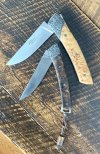 Jolipapa
Jolipapa
A truly fascinating cutlery work, how on earth did M.Pagé have the energy and resources to compile 6 vols in 8 years each c.1400 p??

and no Internet to help out either! A cutlery equivalent of Michelangelo's Sistine Chapel, I'm not exaggerating.
The piece on the Duchy of Finland as it was was interesting: the population of Finland was about 2.5 million (5.5m today) Helsinki/Helsingfors claimed to have a population of 80k but it was almost certainly far bigger, censuses were tricky and inaccurate-nobody wanted to pay tax to either the govt.or the Russians in those days sigh!

Viipuri/Viborg was the second largest city but confiscated by the USSR after 1944 when the war stopped here. Fiskars which gives its name to the metal/tool company (now some multi national corporation with not so much manufacturing in this country anymore like all the other supposed benefits of globalization

) is still a TINY village today about 1000 people but it is a crucible of metal industry. But the thing is the population was very small in those times and most people were still rural and widely scattered with poor communications, this restricted trade plus certain Russian tariffs but it meant a lot of knife smiths were local. They made puukkot, scissors, tools for local use etc but it's interesting to see that there were items exhibited internationally by Finnish makers too.I had to look up Rautalampi, it's some small place in Central Finland, a region I tend to avoid, Lapland too


But like Kauhava today, it was a place where local smiths were making quality knives on some scale.
Interestingly, the word Puukko is used internationally to describe a particular style of Finnish knife, but it doesn't come from one particular area/town as such, but the word is often used here by people to describe any fixed knife (assumption being that if it's fixed & here it will be a puukko even if it isn't

) the word is also used by the Swedish speaking minority in Finland, to which I am attached, as a word in conversation. Similarly, many people associate the Laguiole as The French Knife when it is one, albeit dominant, of many interesting patterns as we can see here on these pages.












